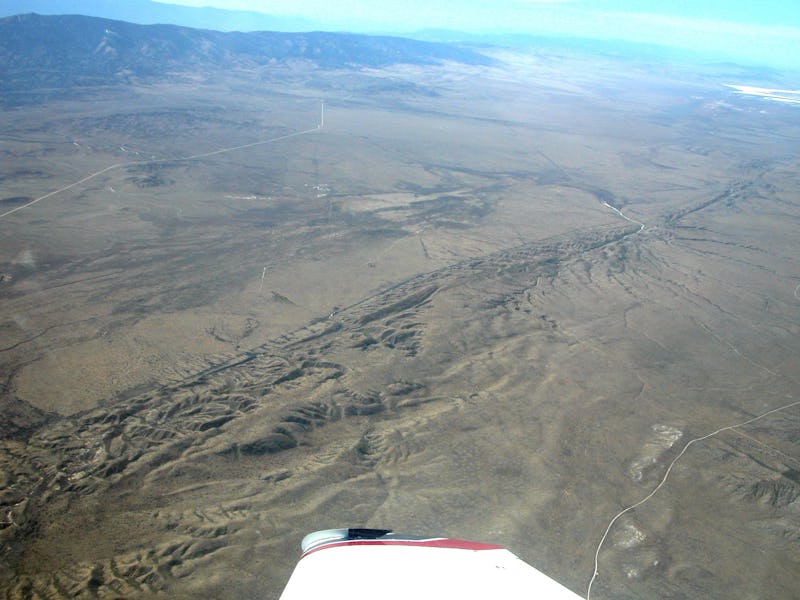Movement Along the San Andreas Just Triggered Media Tremors, Headline Quakes
A new study confirms the already confirmed fact that a quake is coming, shocks journalists everywhere.

California is on edge this week after some earth-shattering news: Large expanses of land are shifting vertically on either side of the San Andreas fault. This has been confirmed by University of Hawaii geologists and resulted in a lot of ink being splashed across the pages of Golden State papers.
The thing is, that unless you’ve been living under a rock for — well, ever — there isn’t anything really new or surprising in this story. The two tectonic plates on either side of the San Andreas fault have been grinding up against each other for some time now. This pressure will inevitably be released in the form of one or multiple earthquakes. If the energy releases all at once, the earthquake will be big and devastating, but no, it won’t look like the movie with The Rock. What researchers have done is supply further evidence of this fact, which is already well supported. That’s good work, but it’s not a great news story.
The fault situates itself between the Pacific plate, which is pushing to the northwest, and the North American plate, which is moving to the southwest. It’s pretty easy to study the lateral motion of the plates relative to each other, but harder to measure what’s going on vertically. That’s because other factors, like pulling water out of aquifers, effect surface elevation. Still, researchers knew that the tectonic movement would cause some elevation change, and had even predicted what it might look like using computer models. This new study is the first to map out which areas are rising and which are sinking in response to movement at the fault using real-world GPS data. The researchers developed a computer algorithm to eliminate other sources of movement from the data by ignoring “noise” in the signal and focusing instead on the bigger trend. Large sections of California, as it turns out, are moving up or down by up to a couple widths of a penny per year in response to the tectonic shifts.
And that’s it. The risk of an earthquake did not just go up.
The news study confirms using physical evidence what had been predicted by previous models.
You’re forgiven for being hopelessly misinformed, though, given the click-baity and fear-mongering headlines that followed the article’s publication. Readers certainly have a responsibility to actually read articles and evaluate the trustworthiness of their content, but they just the last link in a chain of attention-seeking misinformation.
Here are some of the worst offenders:
“Scientists just learned that the San Andreas fault can move up and down, which makes it even more dangerous”
This headline, from Tech Insider, is false. Scientists have long known movement along the fault would result in vertical shifts; they just hadn’t figured out a way to map it out precisely. The fault is no more dangerous as a result. Estimates of the amount of stored energy that could be released in the event of a quake have not changed.
“GPS mapping of San Andreas Fault may give researchers tip as to when it is ready to rupture”
Try again, New Hampshire Voice. This new information does not make eventual San Andreas earthquakes any more predictable.
“San Andreas Movie to Happen in Real Life in 30 Years, Experts Say”
Seriously, Christian Post? Obviously Christians are attached to their apocalyptic scenarios, but maybe at least pretend to stick to the facts? No one can predict earthquakes, only earthquake probabilities. By current estimates, a San Andreas earthquake of magnitude 8.0 or higher has a seven percent chance of occurring in the next 30 years. Also, don’t believe everything you see in Hollywood movies — an actual quake will look nothing like it does on TV.
“WHEN NOT IF: ‘Large-scale movement’ on San Andreas Fault, prompting fears of major quake”
Wow. This one, from notorious tabloid the Express, actually gets points for accuracy. It’s absolutely true that a big San Andreas earthquake is coming no matter what — they tend to occur about every 150 years — though the period between quakes is highly variable and therefore unpredictable. The plates on either side of the fault are indeed moving, and the scale of movement, like the plates, is massive. And, indeed, this news has stoked new anxiety that a big quake is coming, although the fear is no more or less justified then it was before this research came out. You get a gold star for factually correct fear mongering! That’s hard to do.